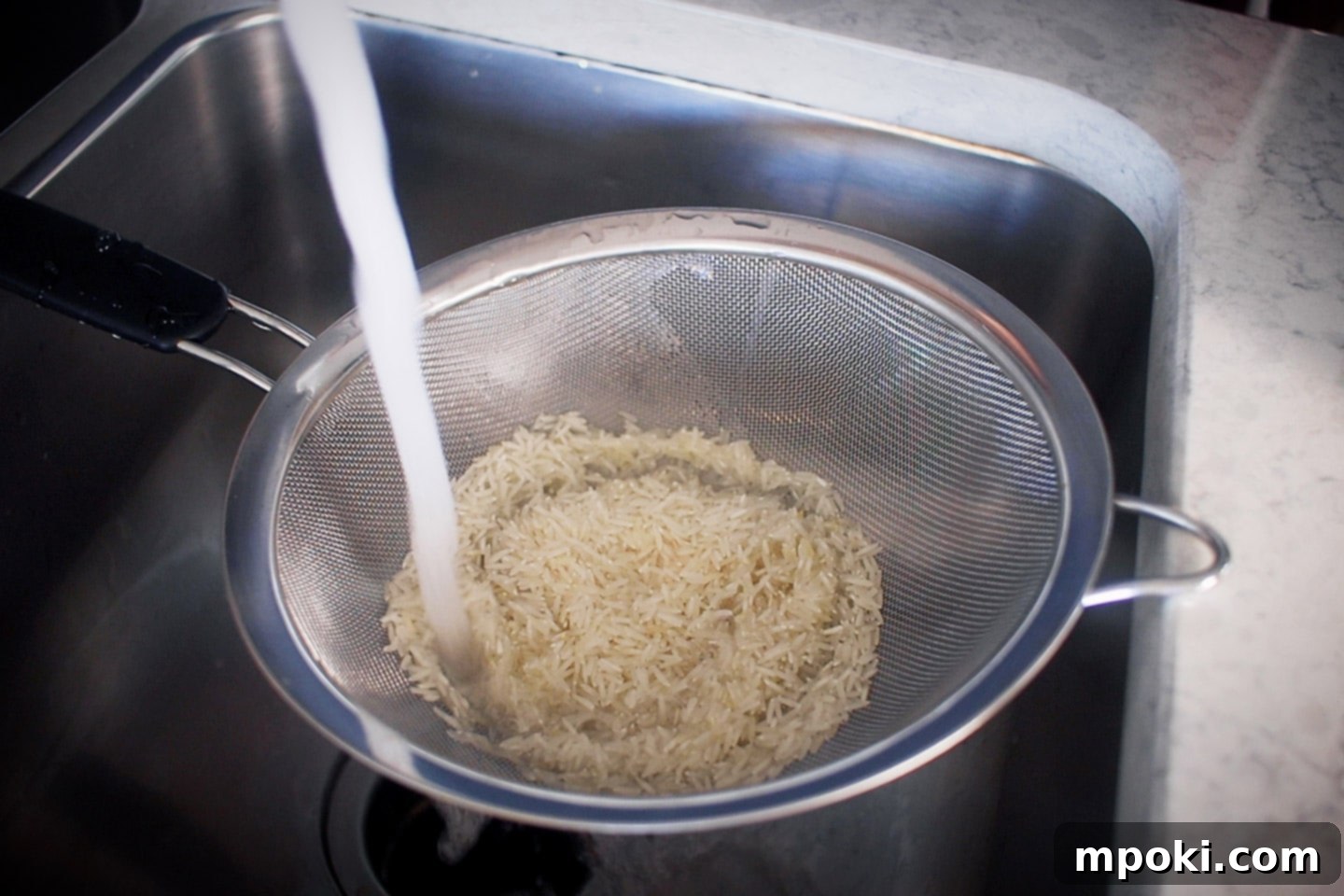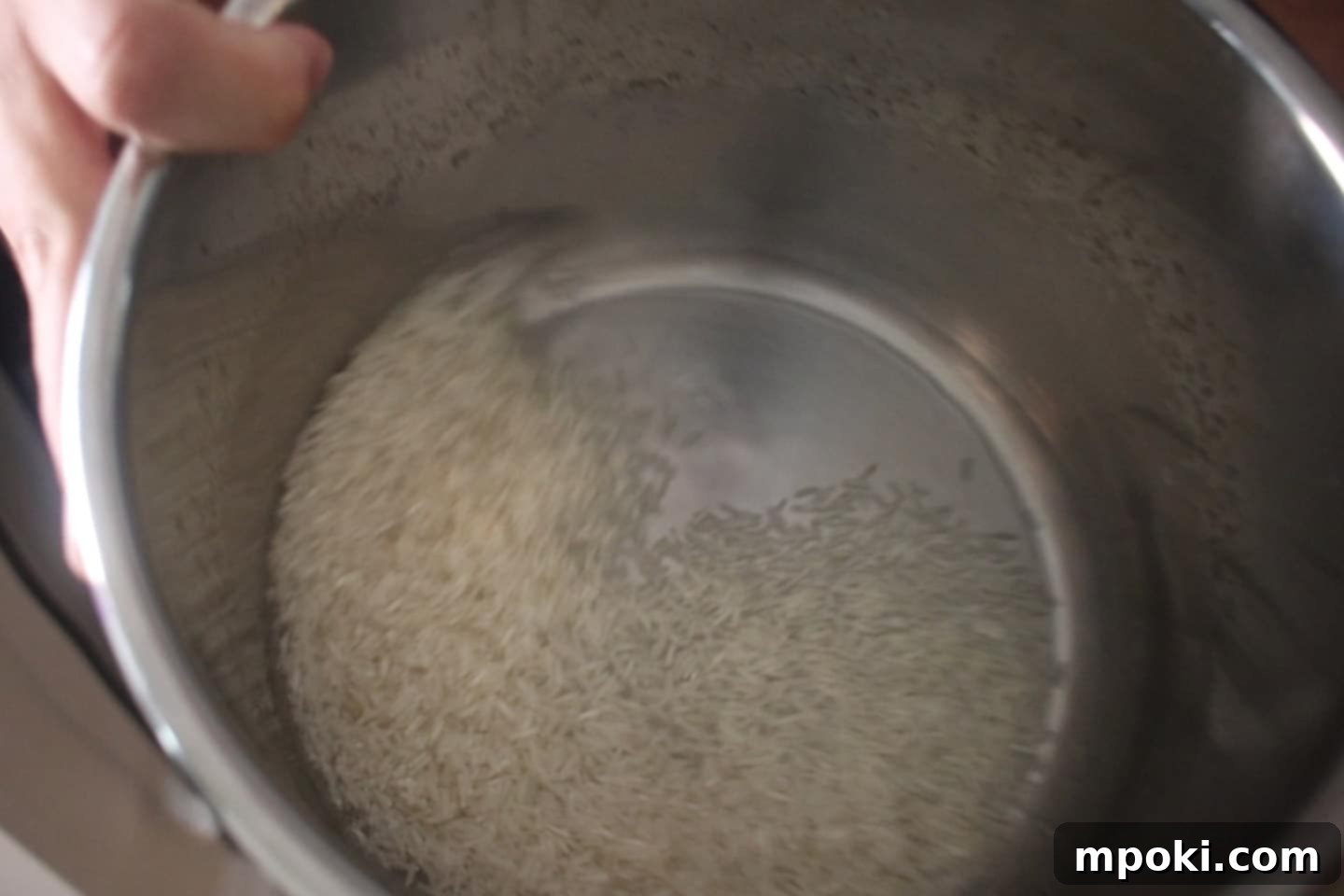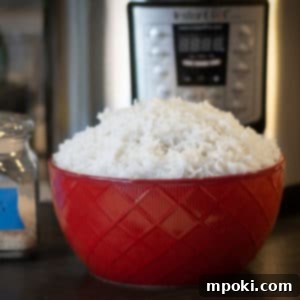Unlock the secret to consistently perfect, fluffy Basmati rice with your Instant Pot! Forget gummy, sticky, or undercooked grains. This comprehensive guide will transform your rice-cooking experience, ensuring each delicate grain of Basmati is separate, tender, and fragrant every single time. Basmati rice, known for its long, slender grains and distinctive aroma, requires a specific approach to achieve its ideal texture – light and non-sticky. While traditional methods can be finicky, the Instant Pot simplifies the process, making it accessible for home cooks of all skill levels. By understanding the unique properties of Basmati and following a few crucial steps, you’ll master this essential side dish and elevate any meal.

This Page Contains Affiliate Links. For more Info See My Disclosures here.
Table of Contents
- The Magic of Basmati Rice in the Instant Pot
- Preparation is Key: Rinsing Your Rice
- The Perfect Water-to-Rice Ratio
- Optimal Cook and Release Times
- Essential Tip for Success
- Serving Your Fluffy Basmati Rice
- Frequently Asked Questions
- Instant Pot Basmati Rice Recipe
- What Goes Great with Basmati Rice?
The Magic of Basmati Rice in the Instant Pot
Basmati rice stands out among other rice varieties due to its unique characteristics. Originating from the Indian subcontinent, it’s a long-grain, aromatic rice renowned for its delicate flavor and light, fluffy texture when cooked correctly. The goal with Basmati is always individual, separate grains – never sticky or clumped. This distinctive quality makes it a perfect accompaniment for rich curries, stews, and a variety of international dishes. However, achieving this ideal texture traditionally requires careful monitoring, precise measurements, and sometimes, a bit of luck.
This is where the Instant Pot becomes your culinary superhero. Pressure cooking creates a consistently controlled environment, ensuring that the rice cooks evenly without excessive evaporation. This leads to perfectly cooked Basmati that’s light, fluffy, and beautifully separated, just as it should be. The “set it and forget it” convenience of an electric pressure cooker also frees you up to focus on preparing the main course, making it an invaluable tool for busy home chefs.
Preparation is Key: Rinsing Your Rice
One of the most critical, yet often overlooked, steps to achieving perfect Basmati rice in your Instant Pot is thorough rinsing. This isn’t just a suggestion; it’s a non-negotiable step that directly impacts the final texture of your rice. When rice grains are harvested and processed, they retain a layer of surface starch. If this starch isn’t removed before cooking, it releases into the cooking water, turning it into a gluey liquid. This gluey starch is precisely what causes rice to become “goopy,” sticky, and clumpy – the exact opposite of what you want for Basmati.
Rinsing the rice under cold running water effectively washes away this excess surface starch. You’ll notice the water appearing milky white at first. Continue rinsing and gently swirling the rice in a fine-mesh strainer until the water runs mostly clear. This usually takes 1-2 minutes, but don’t hesitate to go longer if the water is still cloudy. This simple action makes all the difference, promoting distinct, individual grains that are characteristic of well-cooked Basmati.

The Perfect Water-to-Rice Ratio
For Instant Pot Basmati rice, simplicity is key, and the water ratio is no exception. Unlike stovetop methods where more water might be needed to account for evaporation, the sealed environment of a pressure cooker means very little liquid escapes. This allows for a straightforward 1:1 ratio of rice to water. For instance, if you’re cooking 1 cup of Basmati rice, you’ll use exactly 1 cup of water. If you double the rice to 2 cups, you’ll use 2 cups of water, and so on. This consistent ratio ensures that the rice absorbs just the right amount of liquid to become tender without being waterlogged or dry. You can also add a pinch of salt to the water for enhanced flavor, usually about 1/4 teaspoon per cup of rice.
Optimal Cook and Release Times
Achieving the perfect texture for Basmati rice in the Instant Pot is a balance of precise cook time and a crucial natural pressure release. Through extensive testing, it has been determined that a 7-minute high-pressure cook time followed by a 10-minute natural pressure release (NPR) yields the most consistently excellent results. Here’s why this timing is so effective:
- 7-Minute High Pressure: This duration is ideal for cooking the delicate Basmati grains thoroughly without turning them mushy. The high pressure quickly penetrates the rice, ensuring even cooking from the inside out.
- 10-Minute Natural Pressure Release (NPR): This step is just as important as the cook time. During the natural release, the pressure inside the pot gradually decreases, allowing the rice to continue steaming gently. This resting period lets the grains fully absorb any remaining moisture, firm up, and become incredibly fluffy and separated. Rushing this process by doing a quick release often results in rice that is still a bit hard, or even sticky, as it hasn’t had enough time to redistribute its moisture content evenly. After 10 minutes, you can safely perform a quick release of any remaining pressure before opening the lid.
Consistency is key with these timings, so resist the urge to peek or quick-release prematurely. Trust the process, and you’ll be rewarded with perfectly cooked Basmati every time.
Essential Tip for Success

After you’ve added the rinsed Basmati rice and water to the Instant Pot’s inner pot, take a moment to gently swirl the contents. You can use a spoon or simply rotate the inner pot itself to ensure all the rice grains are fully submerged in the water. This seemingly small step is crucial because it promotes even cooking. Any grains sitting above the waterline may not cook properly, leading to inconsistent texture. A quick swirl ensures every single grain has access to the moisture it needs to become tender and fluffy.
Serving Your Fluffy Basmati Rice
To preserve the perfect, non-sticky consistency of your Basmati rice, it is best to serve it immediately after it’s done cooking and fluffed. Basmati is known for its distinct, separate grains, and leaving it on the “Keep Warm” setting for extended periods can compromise this texture. The heating element at the bottom of the Instant Pot continues to apply direct heat, which can cause the rice at the bottom to become overly dry, crispy, or even stick to the pot. For the freshest and most authentic Basmati experience, serve it hot and enjoy its exquisite aroma and texture right away. If you absolutely must keep it warm, transfer the fluffed rice to a serving bowl and cover it loosely to retain some heat, rather than leaving it in the Instant Pot.
Frequently Asked Questions
Q: Do I need to soak Basmati rice before cooking in the Instant Pot?
A: While some recipes suggest soaking Basmati rice, it’s generally not necessary for the Instant Pot method outlined here. The pressure cooking process is efficient enough to cook the rice perfectly without prior soaking. If you do choose to soak, you might need to slightly reduce the cook time or water ratio, but for consistent results, sticking to the non-soaked method is recommended.
Q: Can I double or triple the Basmati rice recipe in the Instant Pot?
A: Yes, you absolutely can! The beauty of the Instant Pot is that the 1:1 rice-to-water ratio remains constant, regardless of the quantity. So, if you’re cooking 4 cups of rice, you’ll use 4 cups of water. The high-pressure cook time (7 minutes) typically remains the same as well, as it’s the time it takes for the rice to cook once pressure is reached. However, the Instant Pot will take longer to come to pressure and potentially slightly longer for the natural release with larger quantities. Always ensure you do not exceed the ‘Max Fill’ line of your Instant Pot’s inner pot.
Q: My Basmati rice came out too sticky, what went wrong?
A: The most common culprit for sticky Basmati rice is insufficient rinsing. Ensure you rinse the rice thoroughly under cold running water until the water runs mostly clear to remove excess starch. Another possibility is using too much water; always stick to the 1:1 rice to water ratio. Over-stirring after cooking can also release more starch and make it sticky.
Q: My Basmati rice is too hard or undercooked.
A: If your rice is consistently hard, there are a few things to check. First, ensure you’re using the correct 1:1 ratio of rice to water. Second, make sure your Instant Pot lid is properly sealed and the vent is set to ‘Sealing’ (not ‘Venting’) to build full pressure. Finally, ensure you’re allowing the full 10-minute natural pressure release. Releasing pressure too quickly can leave the rice undercooked, as it needs that resting time to finish absorbing moisture.
Q: Can I add butter or oil to my Instant Pot Basmati rice?
A: Absolutely! Adding a teaspoon of butter, ghee, or a neutral oil (like vegetable or canola oil) along with the rice and water can enhance the flavor and contribute to even more separate, non-sticky grains. It also helps prevent foaming during the pressure cooking process. You can also add whole spices like a bay leaf, a cinnamon stick, or a few cardamom pods to infuse the rice with aromatic flavors.
Instant Pot Basmati Rice Recipe

Instant Pot Basmati Rice
Side Dish
Indian
basmati rice instant pot, how to cook rice in instant pot
5
minutes
20
minutes
25
minutes
4
169
kcal
Dad
Equipment
-
▢ Instant Pot or Electric Pressure Cooker
-
▢ Strainer
-
▢ Measuring Cup
Ingredients
-
▢
1
Cup
Basmati rice -
▢
1
Cup
Water -
▢
Optional: Pinch of salt (1/4 tsp per cup of rice) -
▢
Optional: 1 tsp butter or oil
Instructions
- Measure out one cup of Basmati rice into a fine-mesh strainer. Rinse it thoroughly under cold running water for 1-2 minutes, or until the water runs mostly clear. This essential step removes excess starch, preventing sticky rice. Transfer the rinsed rice to the inner pot of your Instant Pot, along with 1 cup of fresh water. If desired, add a pinch of salt and a teaspoon of butter or oil.
- Gently swirl the inner pot or use a spoon to ensure all the rice grains are fully submerged in the water. Place the inner pot into the Instant Pot base. Secure the Instant Pot lid, making sure the silicone sealing ring is properly in place. Rotate the steam release valve to the “Sealing” position.
- Cook on High Pressure for 7 minutes. The setting button may vary by model; for a 6-quart Lux model, typically use the “Manual” or “Pressure Cook” button. Once the cooking cycle is complete, allow the Instant Pot to naturally release pressure for 10 minutes. Do not force a quick release immediately.
- After the 10-minute natural release, carefully move the steam release valve to the “Venting” position to quick release any remaining pressure. Once the float valve drops, you can safely open the Instant Pot lid. Fluff the rice gently with a rice paddle or fork, and serve immediately for the best texture and flavor.
Video
Notes
Nutrition
Calories:
169
kcal
|
Carbohydrates:
37
g
|
Protein:
3
g
|
Fat:
1
g
|
Saturated Fat:
1
g
|
Sodium:
5
mg
|
Potassium:
53
mg
|
Fiber:
1
g
|
Sugar:
1
g
|
Calcium:
13
mg
|
Iron:
1
mg

Tried this recipe?
Mention @DadGotThis or tag #DadGotThis!
What goes great with rice?
Basmati rice is an incredibly versatile side dish that pairs wonderfully with a vast array of cuisines and flavors. Its neutral yet aromatic profile makes it the perfect canvas to complement bold and rich main courses. For an unforgettable meal, why not try it with a classic, flavorful dish?
Give Dad’s Crispy Style Instant Pot Chicken Adobo a try! The tangy, savory flavors of this Filipino favorite are absolutely divine when served over a bed of freshly cooked, fluffy Basmati rice.
Did you know Dad is on YouTube?
For more fantastic cooking videos, step-by-step tutorials, and all sorts of delicious food-related content, be sure to check out Dad’s YouTube channel. Discover new recipes and hone your culinary skills!
